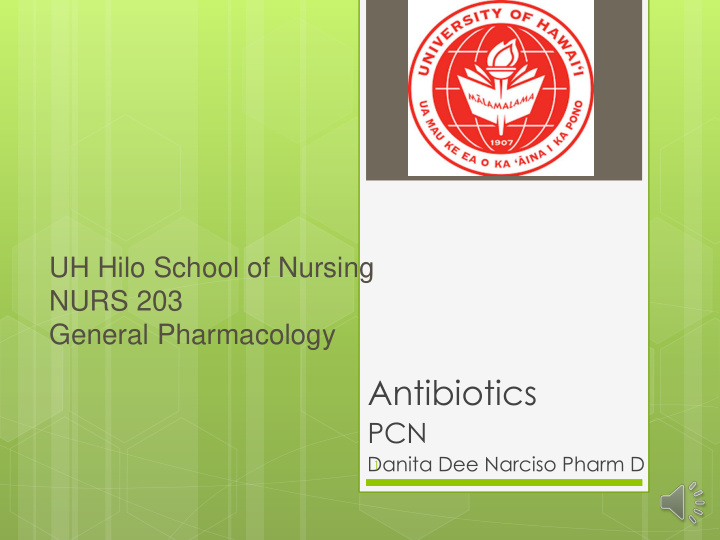



UH Hilo School of Nursing NURS 203 General Pharmacology Antibiotics PCN Danita Dee Narciso Pharm D 1
2 Objectives Recognize the signs and symptoms of infection Become familiar with antibiotics that are commonly used and recognize areas of potential practical conflicts Recognize antibiotics that have interactions with psychoactive medications or illnesses Learn how to monitor for and adjust for changes in drug levels due to interactions with antibiotics
3 Introduction Signs and symptoms of infection Fever WBC increases Normal = 4,000 – 10,000 cells/mm 3 Increases in lymphocytes ~ TB, viral, or fungal infections Increases in monocytes ~ TB or lymphoma Increases in eosinophills ~ Allergy Local signs Pain, swelling, redness, tenderness, purulent discharge
4 Fever (pyrexia) Normal – 98.0-98.6º F (36.7-37ºC) Rectal - 1ºF or 0.6ºC higher Axillary - 1ºF or 0.6ºC lower Hyperpyrexia Hypothermia Other Causes Trauma Malignancy Infarctions Blood disorders Various drugs Immune disorders False positives False negatives
5 Drug induced fever Beta lactams Anticonvulsants Allopurinol (Zyloprim) – Gout Hydralazine – Blood pressure Nitrofurantoin (Macrobid) – UTI Sulfonamides Phenothiazines Methyldopa – Blood pressure in pregnancy
6 Drug induced fever Sulfonamides Phenothiazines Sulfamethoxazole Promethazine Diuretics Chlorpromazine (Thorazine) Anticonvulsants Thioridazine Celecoxib (Mellaril) (Celebrex) Prochlorperazine Sumatriptan (Compazine) (Imitrex) False positives, false negatives???
7 Penicillin
8 Terms Bactericidal Bacteriostatic Beta-lactam antibiotics Beta-lactamases (penicillinase) Penicillin binding proteins (PBPs) Peptidoglycan Transpeptidases
9 Penicillin – a beta-lactam antibiotic
10 Penicillin (PCN) Bactericidal vs bacteriostatic MOA Bind to PBPs, inhibit the reaction (transpeptidase reaction) that cross links the peptidoglycan chain on the bacterial cell wall, and activate autolytic enzymes Time dependent killing The bacteria’s defense Penicillinase (beta-lactamases) Changes in PBPs
11 Penicillins Natural pcn Penicillin G… Penicillin VK Mild to moderate infection without bacteremia of the skin and respiratory tract Gonorrhea – IM Syphilis - IM Neurosyphilis – IM/IV Pharyngitis URI
12 Penicillins Penicillinase resistant Oxacillin Dicloxacillin Nafcillin MSSA infections Erysipelas Skin abscess CNS infections – PCN can penetrate inflamed meninges
13 Penicillins Aminopenicillins Amoxacillin Ampicillin May be used in combination with a beta-lactamase inhibitor Augmentin – amoxicillin and clavulanic acid Unasyn – ampicillin and sulbactam Sinus infection Dental prophylaxis ENT and genitourinary infection Hpylori UTI Meningitis
14 Penicillins Extended spectrum (Carboxypenicillins/ureidopenicillins) Ticarcillin Piperacillin Used in combination with a beta-lactamase inhibitor Zosyn – piperacillin and tazobactam Timentin – ticarcillin and clavulanic acid IV – UTI, systemic infections, complicated abdominal infections, etc…
15 PCN - Kinetics Absorption Oral depends on pH Distribution Lungs, liver, kidneys, muscle, bone, placenta, and urine Metabolism Liver – limited and converted to inactive metabolites Excretion Mostly (60%) unchanged in the urine – monitor renal function Bile – nafcillin and oxacillin
16 Adverse drug reactions GI disturbances Nausea, diarrhea, black hairy tongue (ampicillin), Dermatologic Rash and redness CNS Agitation, anxiety, seizure, confusion, and behavioral changes Psudomembranous cholitis – extended spectrum and aminoPCNs Liver toxicity - oxacillin Be aware when a patient has recently started a penicillin
17 Drug-drug interactions Probenecid Increase PCN concentrations Methotrexate PCNs reduce tubular secretion Tetracycline May reduce the effectiveness of PCNs Chloramphenicol May reduce the effectiveness of PCNs Neomycin Decreases the absorption of some PCNs Hormonal contraception Effectiveness is reduced with the use of some PCNs Anticoagulants PCNs may increase the bleeding risk
18 Allergy Allergy is the most common ADR related to penicillins and can range from itching, fever, and rash to nephritis and anaphylaxis An allergic reaction may occur 1 – 2 weeks after an injection (serum sickness) Oral allergy may present as Tongue swelling Nausea, vomiting, or diarrhea
19 Resistance (Saving our big guns for big bugs) Identify the organism Empiric therapy in some cases
20 PCN and UTI Signs and symptoms General Lower UTI Painful urination, urgency, frequency, nocturia, blood in urine, and suprapubic heaviness Upper UTI Flank pain, fever, nausea, vomiting, and muscle weakness Elderly Altered mental status, change in eating habits, or GI symptoms Indwelling catheters and neurologic disorders Usually develop upper UTI with bacteremia due to the absence of symptoms
21 Questions ?????????????????????????????????? ?????????????????????????????????? ?????????????????????????????????? ?????????????????????????????????? ?????????????????????????????????? ?????????????????????????????????? ?????????????????????????????????? ?????????????????????????????????? ??????????????????????????????????
Recommend
More recommend